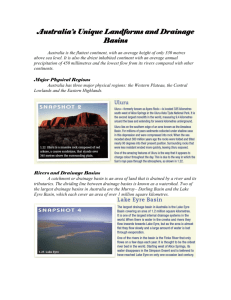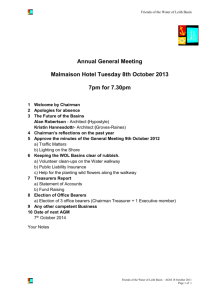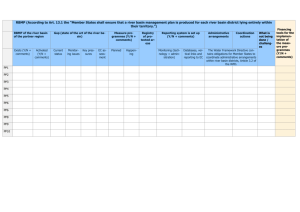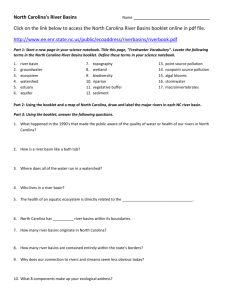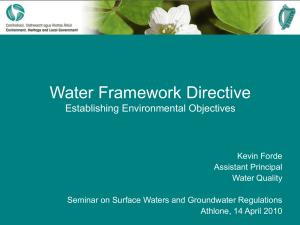Task Packages of the Working Group 4.1
advertisement
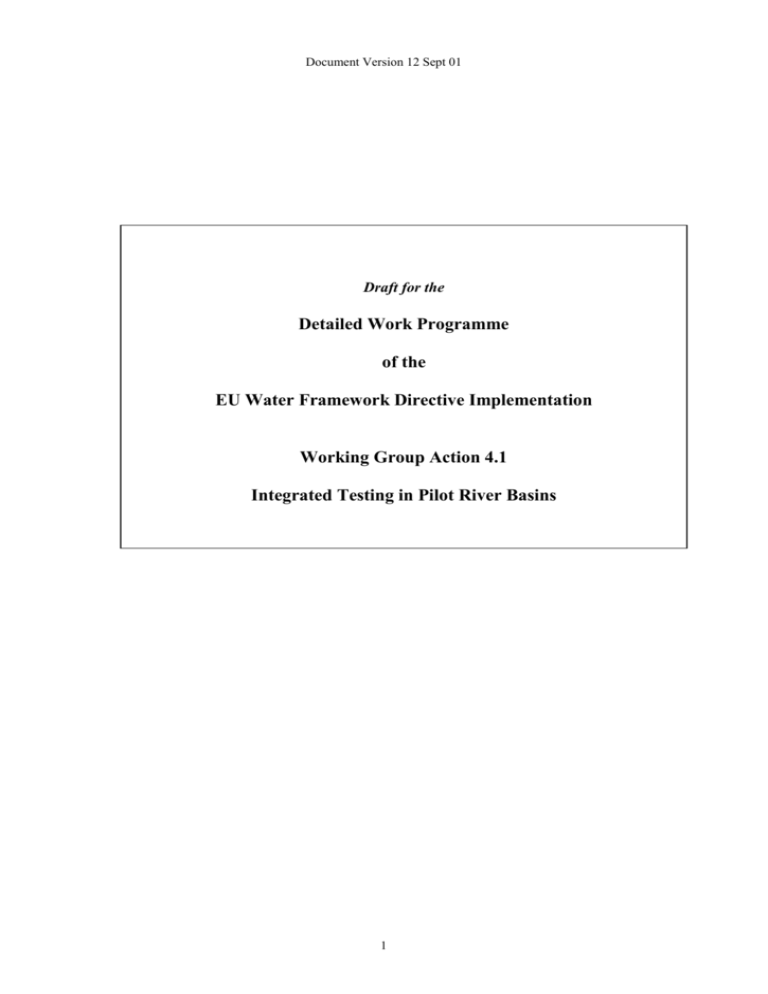
Document Version 12 Sept 01 Draft for the Detailed Work Programme of the EU Water Framework Directive Implementation Working Group Action 4.1 Integrated Testing in Pilot River Basins 1 Document Version 12 Sept 01 TABLE OF CONTENT OBJECTIVES OF ACTION 4.1................................................................................. 3 RATIONAL .................................................................................................................. 4 LINKS WITH OTHER ACTIVITIES/WORKING GROUPS ............................... 6 LEAD ............................................................................................................................ 6 TASK PACKAGES OF THE WORKING GROUP 4.1 .......................................... 7 TP 1. CO-ORDINATION ........................................................................................................................... 7 TP 2. SELECTION OF PILOT RIVER BASINS .............................................................................................. 8 TP3. ORGANISE AN INFORMATION EXCHANGE PLATFORM ........................................................................ 8 TP4. INTEGRATION OF VARIOUS GUIDANCE APPROACHES ........................................................................ 9 TP5. DISSEMINATION OF RESULTS ....................................................................................................... 10 TIMETABLE AND DELIVERABLES ................................................................... 11 2 Document Version 12 Sept 01 Common Strategy on the Implementation of the Water Framework Directive Working Group 4.1 "Integrated Testing in Pilot River Basins" Objectives of Action 4.1 The general objective of the project is to make operational and applicable the Guidance Documents developed under Action 2 and transform them into documents that should be taken into account by regional/local authorities/ water managers by giving concrete examples of application in selected river basins in Europe. The aim is to ensure coherence amongst the different guidance documents and their cross applicability by integrated testing on selected Pilot River Basins. Specific objectives include: harmonising the testing of the practicability and efficiency of the guidance integrating the various guidance documents overview from on-going testing of the WFD in Member States and Working Groups (Action 2) To achieve these objectives a Network of Pilot River Basins (PRB) representing a range of environmental conditions, uses, socio-economic situations and administrative structures, will be set-up. It is important to remember that this project has a horizontal dimension aiming at integrating the outcome of the different Action 2 Working Groups (WGs). It is thus crucial that basins are selected so that many aspects linked with the implementation of the WFD are covered. This should ensure that local and regional diversity and situations are adequately represented. The work plan can be divided into short term and long term goals. In the long term, the focus of WG 4.1 is on the integrated testing of guidelines with regard to their usefulness for the setting up of future River Basin Management Plans. Among activities will be the development of a Guidance Manual (in close collaboration with WG 2.9) based on the results of integrated testing. It is assumed that in the PRB Network, draft programmes of measures are going to be prepared during the testing period. An evaluation of these draft programmes could deliver additional input for the Manual. In the short term it will be necessary to assure that feedback from Member States, WG 4.1 and Action 2 WGs is carried out as efficiently as possible to help in meeting Article 5 commitments. This will be achieved by organising an information exchange from on-going testing activities in Member States and, possibly, through the formulation of specific work programmes and short-term deliverables for selected Pilot River Basins. Furthermore, Member States and river basin organisations will have the possibility to disseminate their specific experiences, e.g. based on national or trans-national pilots if experiences are already available. This will also give the possibility to take on board specific experiences gained at regional and local level. 3 Document Version 12 Sept 01 Rational In order to achieve a successful implementation of the WFD by Member States, the EU Water directors and the Norwegian Water Directors meeting in Paris (23-24 October 2000) agreed on the necessity of a common strategy for the implementation. This meeting further led to the development of a strategic document setting the ground of a harmonised and efficient implementation of the WFD. It is clear that the strategic document follows closely and is structured around the objectives to be met by the WFD and the deadlines to reach these objectives. As stated in the strategic implementation document, the guidance documents should be developed based on already existing practices in Member States with a strong emphasis on pragmatic and operational quality and practicability. It is in sense that the strategic document highlights the needs for testing the guidelines and stresses the constant interaction that should exist between the guidance document and the testing on Pilot River Basins, i.e. the testing and the development of the guidance documents should evolve in parallel. The present paper aims at providing a background document for the identification of the work involved in the testing procedure. As outlined in the strategic document the activities (see Figure 1) about Sharing Information (Activity 1), Development of Guidance (Activity 2), and Information Management (Activity 3) aim at a common understanding of the implementation of the WFD that need to be integrated in the River Basin Management Plans. Activity 4 (Application, Testing and Validation) plays this integration role by making these activities operational in the River Basin Management Plans. The integration step is crucial for the effective implementation of the WFD. As shown in Figure 1, all guidance documents resulting from the different projects must be considered in the Pilot River Basin testing project. 4 Document Version 12 Sept 01 1 Sharing Information 1.1 Tools for information sharing Implementation strategy 1.2 Raising awareness 4 Application, testing and validation 2 Develop guidance 2.1 Analysis of pressures and impacts 2.2 Heavily modified water bodies 2.3 Refrence conditions inland surface waters 2.4 Typology, classification of transitional, coastal waters 2.7 Monitoring 2.5 Intercalibration 2.8 Tools on assessment, classification of groundwater 2.6 Economic analysis 2.9 Best practices in river basin planning 3. Geographical Information Systems 4.1 Integrated testing in pilot river basins 3 Information Management Figure 1. Overall structure of the implementation strategy As can be seen below, Table 1 highlights the urgent need to establish a river basin pilot testing scheme as rapidly as possible in order to ensure that guidance document development complies with the foreseen time scale (2001~2004). Many guidance documents will be available by the end of 2002 (beginning of 2003). This time frame will allow Member States to fulfil their reporting requirement of Article 5 of the Directive (“Characteristics of the river basin district, review of environmental impact of human activity and economic analysis of water use”) by 2004. It is evident, however, that even if the integrated testing in PRBs starts immediately, the outcomes of the evaluation will be available too late to be used efficiently by Member States for their reporting. It is thus clear that the project has to be organised along two time frames. In the shortterm, WG 4.1 should ensure a feedback from activities underway in Member States aiming at testing specific aspects of the WFD (including the integration of Art. 5 requirements that are possible under the given constraints in time). In the long term, the project has to meet the requirements of integrating and testing the various guidance documents on Pilot River Basins in order to develop River Basin Management Plans. 5 Document Version 12 Sept 01 Project 2.1 Beginning date 05-2001 Ending date 12-2002 Project 2.2 12-1999 12-2001/2002 Project 2.3 12-2000 12-2002 Project 2.4 06-2001 06-2002 Project 2.5 06-2001 12-2002 Project 2.6 12-2000 04-2002 Project 2.7 Project 2.8 06-2001 12-1999 2004 12-2001 Project 2.9 2001 2003 Project title Guidance on the analysis of pressure and impact Guidance on designation of heavily modified bodies of water Guidance on classification of inland surface water status and identification of reference conditions Guidance on the development of typology and classification systems of transitional and coastal waters Guidance for establishing the inter-calibration network and intercalibration exercise Develop guidance on economic analysis Develop guidance on monitoring Guidance on tools for the assessment and classification of groundwater Guidance on best practices in River Basin Planning Table 1. Time scale as presently foreseen for the development of guidance documents. Links with other activities/Working Groups Links to all Working Groups developing guidance documents will be needed. Collaboration between Working Group 4.1 and the other WGs has to be activated immediately to allow the flow of information from on-going activities in Member States and the guidance Working Groups. Special attention is needed for the Intercalibration Network (WG 2.5) to ensure that the river basins chosen for testing and validation for WG 4.1 adequately include test sites proposed by WG 2.5. Similarly, adequate connection to WG 2.9 (Guidance on Best Practices in River Basin Planning) has to be established, especially in relation to River Basin Management Plans. It is envisaged to finalise the selection of Pilot River Basins by early-2002 and start preliminary work for the integrated testing as soon as the selection phase is over. Finally close links will be needed with WG 3: Information Management (Geographical Information Systems). GIS tools will play an important role both in the development of RBMP and in more general reporting procedures, as well as in the integrated testing. Lead The Strategic Co-ordination Group (chairman European Commission) has the responsibility of Action 4.1. In order to facilitate the development of this Action, the 6 Document Version 12 Sept 01 EI-JRC will be in charge of running of a Technical Secretariat (see Task Package 1 below). Task Packages of the Working Group 4.1 Five Task Packages are foreseen in this project and will be detailed in the remainder of the document: TP1. TP2. TP3. TP4. TP5. Co-ordination Selection of Pilot River Basins Organise a platform for information exchange Integrated testing of various guidance approaches Dissemination of results. The TP 2 and TP 3 outline short-term activities, while TP 4 and TP 5 describe longerterm initiatives. TP 1. Co-ordination The Strategic Co-ordination Group will lead Key Activity 4.1 jointly with the Member States and institutions in the selected Pilot River Basins. The EI-JRC will be responsible for a Technical Secretariat. Objective: The work will focus on the administration and coordination of the WG 4.1. The EI-JRC will assure the day to day running of the Secretariat on behalf of the Strategic Co-ordination Group, with the specific task of providing a smooth flow of information among partners of the different WGs and with other relevant projects, of organising meetings and providing progress reports. Working method: The EI-JRC will be responsible for a Technical Secretariat having as mission to ensure: (i) the practical day to day functioning of the project, information exchange, and support activities, (ii) that identified tasks carried out by the different groups involved are feasible and coherent with the objectives of the project, (iii) that the selected Pilot River Basins have comparable technical support to carry out their studies, and (iv) to assure that efficient inter-comparison analysis between those studies is carried out. A kick–off meeting took place at the JRC Ispra (9-10 July 2001) to initiate contacts among the different partners and to determine short, mid and long-term objectives. It was decided that a document including the key characteristics for selecting the Pilot River Basins (see first draft in Annex I) is to be developed before the next Water Director meeting in November 2001. A report on the structure, working programme and time schedule for Action 4.1 will be submitted to the Strategic Co-ordination Group at its next meeting on 17th September 2001 7 Document Version 12 Sept 01 TP 2. Selection of Pilot River Basins Objective: This work package will be concerned with identifying the key characteristics for selecting the Pilot River Basins (PRBs). Selection parameters are given in the draft in Annex I and include criteria such as representativity of larger geographical regions, data availability, involvement of stakeholders and end-users, etc. The PRB Network should cover a wide range of environmental and political conditions. Further, the catchments should be broad enough to encompass a significant class of environmental problems linked with water management. The selection of basins already involved with the implementation of WFD or other water Directives with implication of local authorities and end-users may help optimise the use of resources. Working Method: The WG 4.1 is producing a list of key characteristics based on the discussions that took place during the kick-off meeting. The WG is also in charge of developing a questionnaire that will summarise the catchment properties, environmental pressure and impacts, on-going research activities, etc. All activities and proposals are welcome and selection criteria are considered to be of help not only to the Strategic Co-ordination Group, but also to Member States for selecting pilot projects. Based on the final proposal by Member States, a Network of PRBs, including associated coastal zones where applicable, representative of a range of problems and conditions will be set up. The selection of nodes of the Network will be completed by the first semester 2002, and will be documented in a report to be delivered by June 2002. TP3. Organise an information exchange platform Objective: The major aim of this task is directed at providing short term support to Member States and Working Groups (Action 2) in meeting their reporting obligation under Article 5 of the WFD. The specific objectives of this Task Package are (i) to organise an exchange of information from pilot activities taking in place in Member States, and (ii) to make this information available as soon as possible to the relevant Working Groups in charge of developing guidance documents. Working method: Due to the need to meet reporting deadlines of 2004 (Article 5 of the Directive) Member States have already started testing the implementation of specific aspects of the WFD. The focus of this task is thus to set-up a platform for information exchange among Member States where new experience of organisations already applying guidelines as well as experience of future pilot projects is made accessible as soon as possible. This information may be useful also to WGs in charge of developing guidance documents. The WG 4.1 should also discuss the possibility of preparing, immediately after the selection of the PRBs in springtime 2002, a smaller scale/shorter term integrated testing of guidelines to be carried out starting at the beginning of 2003 profiting of existing initiatives in an appropriate sub-set of the PRB Network. Main actions will be: 8 Document Version 12 Sept 01 3.1 Develop a document detailing activities linked with the implementation of the WFD already in place in pilot basins in Member States and WG's. This will provide an overview of the studies that can be of benefit both to Member States and to WGs in charge of developing guidance documents, and also limit duplication of existing work. A preliminary review of pilot studies dealing with the implementation of the WFD based on documents provided so far by Member States will be added as Annex II (to be distributed once all MS have provided the information required). 3.2 Organise two technical workshops; one taking place in spring 2002 and the second in spring 2003, where strategies on the implementation of the WFD, problems encountered and solutions adopted will be discussed. This will also serve as a preparatory step for the integration of the different guidance documents in the later phase of the project (TP4). TP4. Integration of various guidance approaches Objective: The objectives of this Task Package is to provide support to the integrated testing of the various guidance approaches in the longer term. Specific objectives are: (i) to put together and integrate the experiences and knowledge gained from the testing of individual guidance documents, and (ii) to evaluate further needs to achieve efficient implementation of the WFD, and more specifically the development of River Basin Management Plans (including programme of measures and the other items listed in Annex VII of the Directive). Working Method: Once all guidance documents will be tested individually, it will be important to assess their complementarity and efficiency in meeting the objectives set by the WFD. To this end, it is proposed to conduct a full development of River Basin Management Plans for the PRBs (in collaboration with WG 2.9), including all aspects listed in the Annex VII of the Directive, to carry out cross basins comparisons in order to evaluate the transposability to different conditions and environment, and to develop a Guidance Manual for use by regional/local water authorities/water managers. 4.1 Ensure that all persons involved in the PRB studies are proficient in using the various guidance documents. This task will be performed in collaboration with each WG through the organisation of ad-hoc meetings. 4.2 Integration of all evaluation of the guidance documents on the selected PRBs. 4.3 Determination of additional requirements to meet the WFD. 4.4 Development of the programme of measures for the selected site to reach environmental objectives, including basic and supplementary measures. 4.5 Development of the River Basin Management Plans It is envisaged to start organising the work for the PRB testing, expected to begin early 2003, once the PRB Network will be selected (springtime 2002). This will be achieved with a series of meetings involving key partners in the Network. Member States not proposing a PRB may contribute to the integrated testing of guidance documents on a specific river basin representative of conditions in their country. It is 9 Document Version 12 Sept 01 proposed under this task to organise the work interest of each Member State for the PRBs, and get all the persons involved in the testing in PRBs proficient with the guidance documents. Final Report: A final report elaborated in collaboration with WG 2.9 will be delivered by December 2005, including the results of the integration of the guidance documents and additional steps taken to develop River Basin Management Plans on the PRBs. The step by step approach used during the testing and integration procedure will be detailed in the final document. This document will be used to ensure the reproducibility of the results by any end-users wishing to use the guidance documents for the full implementation of the WFD. It is clear that Tasks 4.3 and 4.4 may prove difficult given the present time scale of the Implementation Project and the associated resource needs. However, some work will be already done in the PRBs in order to meet with the reporting procedure for Article 5 of the WFD that has to be concluded by 2004. The development of River Basin Management Plans will build on this preliminary work. Attempt should be made to produce a first draft of the Guidance Manual during 2003, which should include examples of Member State’s experience taking into account each countries specific formal setting. It is also important to underline that because of the specificity of each PRB, the integrated testing may not have the same timetable and objectives for each basin, but different time schedules and deliverables. TP5. Dissemination of results Objective: Develop an approach for the dissemination of results, targeting especially the groups of people taking part in the integrated testing in the PRBs. Activities should include exchange of information, examples and experience, and demonstration cases. Working Method: In order to strengthen the development of a common strategy for the implementation of the WFD, special attention must be given to providing for the dissemination of results from Member States on the experience they have gained during the testing in the PRBs. This should include experience on the utilisation of guidance documents, in the techniques and methodologies used for their employment and the compatibility of application across EU Member States, exchange of experience in specific pilot studies and the development of demonstration cases. This will be particularly important to ensure the reliability of the results and to decrease the risk of distortion and divergence of measures underpinning the efficient application of the Water Framework Directive. 5.1 Information gained by Member States during the development of guidance documents and testing will be collated in order to summarise the experience gained throughout the EU during this phase of implementation. 5.2 On the basis of examples of the results of integrated testing of guidance documents, demonstration cases will be identified. 10 Document Version 12 Sept 01 It should be noted that detailed training is the responsibility of Member States and that the present Task Package should only provide complementary information and tools for groups of people taking part in integrated pilot basin testing. Timetable TP 2001 2002 2003 2004 2005 01 02 03 04 01 02 03 04 01 02 03 04 01 02 03 04 01 02 03 04 1 2 3.1 3.2 4.1 4.2 4.3 4.4 4.5 5.1 5.2 TP1. TP2. TP3. TP4. TP5. Co-ordination (Technical Secretariat) Selection of Pilot River Basins Exchange platform among MS 3.1 Survey of existing activities linked to the WFD in MS 3.2 Organise information exchange Integration of various guidance approaches 4.1 Proficiency in using guidance documents 4.2 Integration of the different guidance documents 4.3 Additional requirements to meet the WFD 4.4 Evaluation of programme of measures 4.5 Development of River Basin Management Plans Tools and dissemination of results 5.1 Examples and experiences 5.2 Demonstration cases Deliverables TP2. 06-2002. Report on the Pilot River Basin Network TP3.1. 09-2002. Report on on-going activities related to the WFD in MS TP3.2. 06-2002. Report on MS meeting about WFD implementation workshop #1 TP3.2. 06-2003. Report on MS meeting about WFD implementation workshop #2 TP4.2. 08-2003. First draft of Guidance Manual 11 Document Version 12 Sept 01 TP4.4. 12-2005. Guidance Manual reporting experiences on RBMP TP5.2. 12-2004. Dissemination of scenarios and management options. 12 Document Version 12 Sept 01 ANNEX I Key Characteristics for Pilot River Basins Introduction The WG 4.1 during its first meeting in 9-10th July at the JRC (Ispra) discussed a list of key characteristics for candidate river basins to be proposed by Member States as Pilot River Basins. However, it should be emphasised that Pilot River Basins will be run and financed by Member States and, as a consequence, this list must be considered as a wishing list more than a formal selection list. Furthermore, it is intended to cover the widest possible range of characteristics in the selected Pilot River Basins and, hence, the different problems found in water districts at European level. Finally, the characteristics are listed according to their relative importance. In order to ensure an efficient co-operation and co-ordination within the PRB network, the number of PRBs should not exceed ten. All proposals are welcome and selection criteria are considered to be of help not only to the Strategic Co-ordination Group, but also to Member States for selecting pilot projects. List of key characteristics : 1. Ecoregions: The selected Pilot River Basins should cover the maximum number of Ecoregions, as defined in the Water Framework Directive Annex XI. This should concern not only rivers and lakes (25 Ecoregions), but also transitional and coastal waters (6 Ecoregions). 2. Commitment and resources: The participation of a river basin in the WG 4.1 will imply that resources in terms of people and money should be devoted to test several Guidance Documents on that river basin. Therefore, it is fundamental for candidate river basins to be able to show that this premise already exists. 3. Institutional aspects: Local, Regional and National competent authorities should be involved in the respective Pilot River Basins working group. This will ensure that information is disseminated as well as that all the relevant aspects of the River Basin Management Plan are addressed and studied at adequate level. A transboundary river basin should also include the same level of representation by each participant country. 4. NGOs and stakeholders: It is important for the appropriate implementation of the WFD that candidate river basins have identified and planned to include representatives not only from the competent authorities (above point) but also NGOs, the social and economical partners, consumer bodies, academics and other experts. 13 Document Version 12 Sept 01 5. Pressures and environmental problems: For each candidate river basin a list of pressures and environmental problems should be identified. The final selection should try to cover the maximum number of them. 6. Transboundary: Due to the special characteristics of transboundary river basins it is important to include at least one representative example in the Pilot River Basins Network. 7. National projects: The existence of National Projects already running on the selected river basin would help considerably in the creation of the Pilot River Basin Network and in accelerating the process of testing the selected Guidance Documents. Furthermore, an existing running project will require less new resources than a new project. 8. Independence from other WGs: There are several Guidance Documents that have been or are being tested in selected areas. Repeat testing (under Action 4.1) of the same Guidance Document in the same site would, therefore, not be independent and would not increase the case studies in such Guidance Document. However, the testing of other Guidance Documents in such sites may help in the harmonisation procedure between several Guidance Documents, and may also help optimise the use of resources. 9. Intercalibration points: It would be convenient for both WGs (2.5 and 4.1) to have the maximum number possible of common sites. For WG 2.5 because changes and trends in point measurements could only be understood by looking at processes at the catchment scale, and for WG 4.1 because the creation of an Intercalibration Network would help the focusing of resources on selected Pilot River Basins. 10. Scale: The scale should be adequate to represent a Pilot River Basin for a specific water district. A full range of scales covering the variability in Europe should be ensured. 11. Water bodies: The maximum number of water bodies, i.e. groundwater, heavily modified bodies, lakes, transitional water, coastal zone, should be included in each PRB. 12. Data availability: In order to make case studies as complete as possible (especially for the development of River Basin Management Plans), different levels of data availability should be studied, from PRBs where a lot of data exists to others in which more limited data are available. 14

